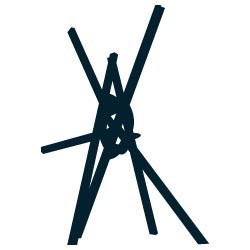Mark di Suvero For Adolescents

Clock Knot
Mark di Suvero
Subject: Balance and lift
Activity: Creating a sculpture with balance and lift
Materials: Acrylic paint (optional), sticks, wooden beams, or metal rods (such as discarded curtain rods or rebar)
Vocabulary: Balance, crane, lift
Mark di Suvero was born to Italian parents in Shanghai in 1933. He grew up in San Francisco. After attending college, he moved to New York City and settled in lower Manhattan. The area, near the Fulton Fish Market, was rapidly changing. Buildings were constantly being torn down while new ones were being raised. Di Suvero began collecting materials that he found at the demolition sites, including large wooden beams. He then chained the beams together to create sculptures. Throughout his career, he has been interested in balance and lift, perhaps as a reaction to his early years watching the creation of some of Manhattan’s most impressive skyscrapers.
Clock Knot suggests an enormous clock face with a clock hand extending from the center. However, upon walking around the sculpture, the viewer discovers that the clock hand is really part of an inverted V. The word “knot” in the title then becomes a play on words, referring both to the tangle in the center of the sculpture and the fact that this is “knot/not” a clock. The sculpture is so massive and heavy, di Suvero had to use a crane—as he does for all of his large sculptures—to move the beams into position. He then carefully constructed the sculpture so that it would be stable, despite its precarious angles.
Like Clock Knot, the structural framework of a skyscraper is made from steel beams. In terms of the purpose and construction of these two forms, what similarities or differences can you identify?
Do you think the sculpture looks balanced? How difficult do you think it was for di Suvero to achieve balance?
Walk around the sculpture. How does the sculpture change? Walk under the sculpture. What is this experience like?
Collect such objects as sticks, wood beams, or metal rods (such as discarded curtain rods or rebar). Try to balance the objects together in a sculpture with a vertical movement. You may choose, like di Suvero, to use chains to keep the pieces together. You might also use bungee cord or rope. When you are done, paint your sculpture with acrylic paint if you like.
In a 1983 interview with Architectural Digest, di Suvero explained his process: “When you pick up a large weight with a crane, you need a sense of its center of gravity. This is something dancers understand: the way you can control a weight by shifting its center. Working near the limits of a crane’s capacity, it’s very easy to make a mistake. A cable can snap; the whole rig can tip over. So the process is delicate—like playing a violin. I try to get some of that sense of balance into my work. Just because a sculpture is big, it doesn’t have to be rigid.”
Tony Smith’s Amaryllis is also made from steel and then painted a solid color. How are Amaryllis and Clock Knot similar or different? How do you think the material affected the building of each of the sculptures? Which sculpture looks heavier? Why do you think Smith and di Suvero painted their sculptures?
Balance - to keep steady
Crane - a machine for raising, shifting, and lowering heavy weights
Lift - lifting up or elevating; an elevation of the spirit
